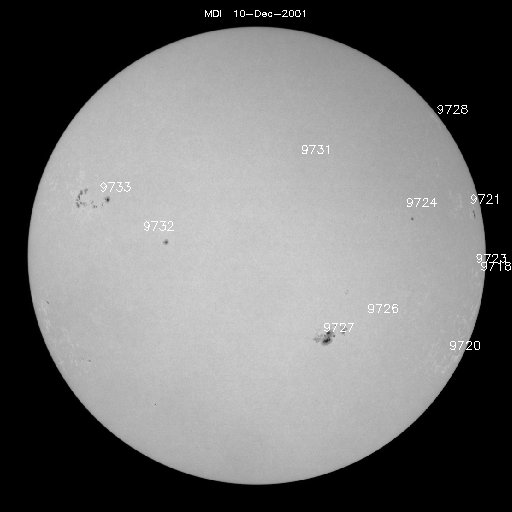Viewing archive of Monday, 10 December 2001 - Sunspot regions

Courtesy of SDO, SOHO (NASA) and the [MDI, AIA, EVE, and/or HMI] consortium.
| Sunspot number | New regions | Background flux | Maximum flux | C | M |
|---|---|---|---|---|---|
| 224 -1 | 3 2 | C1.86 | M1.24 | 4 | 2 |
Sunspot regions
Region 9717 |
||||
|---|---|---|---|---|
| Number of sunspots |
Size | Class Magn. | Class Spot | Location |
| 1 | 70 -30 | HSX | N05W88 | |
Region 9718 |
||||
|---|---|---|---|---|
| Number of sunspots |
Size | Class Magn. | Class Spot | Location |
| 10 -5 | 280 -190 | DAO | S06W76 | |
Region 9720 |
||||
|---|---|---|---|---|
| Number of sunspots |
Size | Class Magn. | Class Spot | Location |
| 9 -1 | 40 -10 | DSO | S28W63 | |
Region 9721 |
||||
|---|---|---|---|---|
| Number of sunspots |
Size | Class Magn. | Class Spot | Location |
| 3 -1 | 110 10 | DAO | N11W64 | |
Region 9723 |
||||
|---|---|---|---|---|
| Number of sunspots |
Size | Class Magn. | Class Spot | Location |
| 3 | 40 | CSO | S05W68 | |
Region 9724 |
||||
|---|---|---|---|---|
| Number of sunspots |
Size | Class Magn. | Class Spot | Location |
| 1 -4 | 30 -10 | HSX | N10W33 | |
Region 9726 |
||||
|---|---|---|---|---|
| Number of sunspots |
Size | Class Magn. | Class Spot | Location |
| 8 | 40 -20 | DSO | S16W22 | |
Region 9727 |
||||
|---|---|---|---|---|
| Number of sunspots |
Size | Class Magn. | Class Spot | Location |
| 23 2 | 360 -10 | DAI | S20W10 | |
Solar flares on this day | ||||
| M1.24 C3.33 C6.05 | ||||
Region 9728 |
||||
|---|---|---|---|---|
| Number of sunspots |
Size | Class Magn. | Class Spot | Location |
| 5 1 | 50 -20 | ESO | N35W71 | |
Region 9731 |
||||
|---|---|---|---|---|
| Number of sunspots |
Size | Class Magn. | Class Spot | Location |
| 5 2 | 10 -10 | BXO | N25W04 | |
Region 9732 |
||||
|---|---|---|---|---|
| Number of sunspots |
Size | Class Magn. | Class Spot | Location |
| 4 -1 | 60 -20 | CSO | N04E36 | |
Region 9733 |
||||
|---|---|---|---|---|
| Number of sunspots |
Size | Class Magn. | Class Spot | Location |
| 21 2 | 290 50 | EAI | N14E58 | |
Solar flares on this day | ||||
| M1.01 | ||||
Region 9734 |
||||
|---|---|---|---|---|
| Number of sunspots |
Size | Class Magn. | Class Spot | Location |
| 2 | 50 | CAO | S12E81 | |
All times in UTC
Latest news
Latest forum messages
Coronal Hole 06 58Geminid Meteor Shower 29Incoming & Unnumbered Active Regions 39Current Farside Activity 254Returning Carrington 14
More topicsSupport SpaceWeatherLive.com!
A lot of people come to SpaceWeatherLive to follow the Solar activity or if there is a chance to see the aurora, but with more traffic comes higher costs to keep the servers online. If you like SpaceWeatherLive and want to support the project you can choose a subscription for an ad-free site or consider a donation. With your help we can keep SpaceWeatherLive online!
Space weather facts
| Last X-flare | 2025/12/08 | X1.1 |
| Last M-flare | 2025/12/12 | M1.1 |
| Last geomagnetic storm | 2025/12/12 | Kp5 (G1) |
| Spotless days | |
|---|---|
| Last spotless day | 2022/06/08 |
| Monthly mean Sunspot Number | |
|---|---|
| November 2025 | 91.8 -22.8 |
| December 2025 | 128 +36.2 |
| Last 30 days | 108.4 +15.8 |





